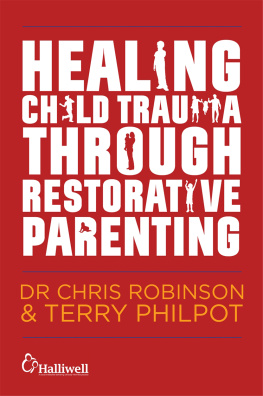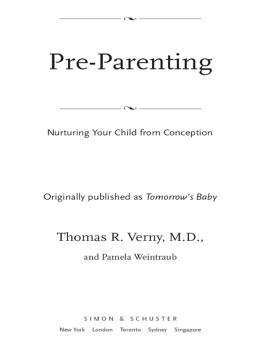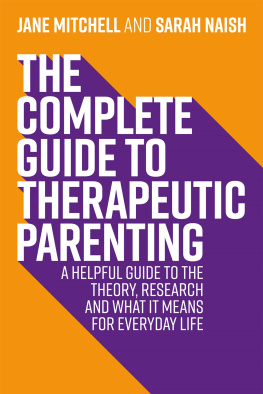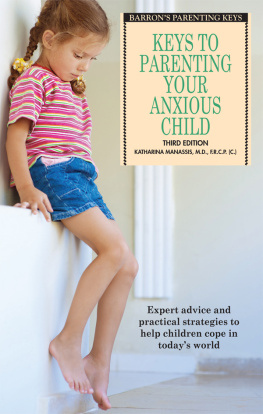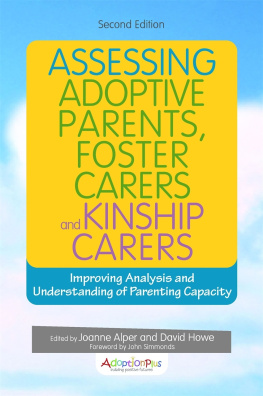
Reparenting the Child Who Hurts
Reparenting the Child Who Hurts
A Guide to Healing Developmental Trauma and Attachments
Caroline Archer and Christine Gordon
Foreword by Gregory C. Keck, Ph.D.

Jessica Kingsley Publishers
London and Philadelphia
First published in 2013
by Jessica Kingsley Publishers
116 Pentonville Road
London N1 9JB, UK
and
400 Market Street, Suite 400
Philadelphia, PA 19106, USA
www.jkp.com
Copyright Caroline Archer and Christine Gordon 2013
Foreword copyright Gregory C. Keck, Ph.D. 2013
All rights reserved. No part of this publication may be reproduced in any material form (including photocopying of any pages other than those marked with a , storing it in any medium by electronic means and whether or not transiently or incidentally to some other use of this publication) without the written permission of the copyright owner except in accordance with the provisions of the Copyright, Designs and Patents Act 1988 or under the terms of a licence issued by the Copyright Licensing Agency Ltd, Saffron House, 610 Kirby Street, London EC1N 8TS. Applications for the copyright owners written permission to reproduce any part of this publication should be addressed to the publisher.
Warning: The doing of an unauthorised act in relation to a copyright work may result in both a civil claim for damages and criminal prosecution.
Library of Congress Cataloging in Publication Data
Archer, Caroline, 1948
Reparenting the child who hurts : a guide to healing developmental trauma and attachments / Caroline
Archer and Christine Gordon ; foreword by Gregory C. Keck, Ph.D.
pages cm
Includes bibliographical references and index.
ISBN 978-1-84905-263-4 (alk. paper)
1. Child psychology. 2. Child development. 3. Adoptive parents--Handbooks, manuals, etc. 4. Parenting--Handbooks, manuals, etc. I. Gordon, Christine Ann, 1949- II. Title.
BF721.A6943 2012
649.1567--dc23
2012033827
British Library Cataloguing in Publication Data
A CIP catalogue record for this book is available from the British Library
ISBN 978 1 84905 263 4
eISBN 978 0 85700 568 7
Printed and bound in Great Britain
We would both like to dedicate this book to our grandchildren. The challenges of the next generation continue to allow us to practise and hone our developmental reparenting principles. Thanks to them all, and our children, for the opportunities they have given, and are giving us, to have fun whilst continuing to learn.
Foreword
As I read the book that you are about to begin, I felt excited that so much recent information is included. Caroline Archer and Christine Gordon have clearly researched the most recent literature in neuroscience, trauma, human development and developmental parenting.
As a professional, I felt that the material contained in this book offers those people working with hurt children and their families insight and information which will better inform their practices and enhance their efforts to help traumatised children move forward in their development. As an adoptive parent, I felt the strong encouragement that is offered on almost every page. As I read through the manuscript a couple of times, I was glad to see theoretically sound and well-researched information presented in a manner that will be palatable to frustrated and challenged parents.
When a child who has been traumatised enters a family either for foster care or for adoption, they bring a lot with them. Much of what he/she brings may not be expected by the family, and even more importantly, it is almost certain that the family parents and children will not expect the childs trauma experiences, emotions and behaviours to have a negative or even traumatic impact on the family. When professionals see prospective adoptive families, they appear to be healthy, excited, optimistic, forward looking and hopeful that they will be able to raise a hurt child; they often feel that their love and acceptance will erase the hurt or, at least, mitigate it enough so that the child will have a bright and productive future.
Hurt children bring their hurt their many hurts with them, and often both parents and other children in the family feel as if they are now living in an environment that is both traumatic and hurtful. I feel that Caroline Archer and Christine Gordon offer hope for families who may be struggling and flailing about trying to find their feet, so to speak. While the book is not a step-by-step guide, which I dont even believe could be written, Reparenting the Child Who Hurts offers readers a conceptual framework for understanding the complex dynamics of living with a child who, indeed, has developmental trauma disorder. It also provides explicit details of how parents may respond to difficult situations complete with examples of verbal responses that may be helpful in ameliorating extremely intense situations.
New developments in neuroscience offer us so much insight, and this book integrates this new knowledge with the long-understood dynamics of child and human development. I believe that when parents are able to maintain a focus on developmental issues as they make their way through the maze of emotions, behaviours, challenges and difficulties, they are able to keep their heads high enough above the water to allow them to make reasoned decisions about what they want to address and what they may want to do. When parents can make a shift in how they see the problems the hurt child has and in how they respond to the child, the child will have fertile ground for developmental re-activation and progress.
I think that readers of Reparenting the Child Who Hurts will find, as I did, that this book will help them understand the dynamics they either work with or live with and, more importantly, it will help them make the kinds of shifts that will facilitate their efforts to parent and help hurt children.
Gregory C. Keck, Ph.D., Founder/Director of the Attachment and Bonding Center of Ohio; co-author of Adopting the Hurt Child and Parenting the Hurt Child; and author of Parenting Adopted Adolescents
Part 1
Stepping
Forward
Exploring the Foundations
Introduction
When we first met in the late 1980s and began work with colleagues at Adoption UK (then Parent to Parent Information on Adoption Services (PPIAS)) to explore how parenting hurt children (Keck and Kupecky 2002) differed from parenting securely attached children, little did we know that, two decades on, we would still be working together exploring the needs of traumatised children and discussing how best to parent them. Little, too, did we know the extent to which new developments in neurobiology would increase our understanding of the continuing day-to-day struggles that affect the lives of many traumatised children even when they have been removed from their traumatic circumstances and offered the security of loving families.
When we first started writing together in the late 1980s a climate change in the way adoptive family life was perceived was beginning. John Bowlbys research on attachment (1969, 1973, 1988) was increasingly recognised as pertinent to our understanding of how our earliest relationships, particularly those with our mothers, crucially determine how we relate to the world and our relationships within it. This eventually led to greater awareness amongst the adoption community that early trauma continues to have an adverse impact long after children are placed in loving families. This began a movement away from blaming adoptive parents for the ongoing difficulties their children presented to an understanding that on its own love does not conquer all.
Next page



